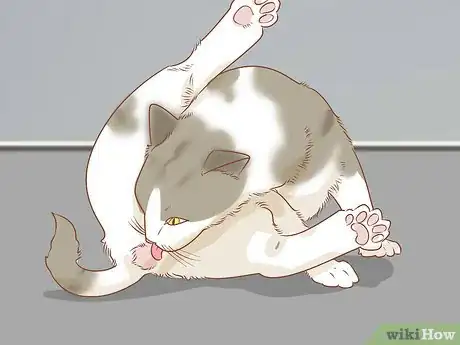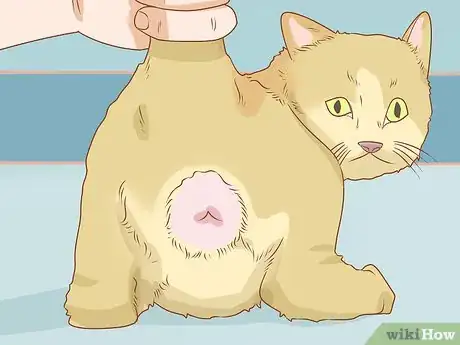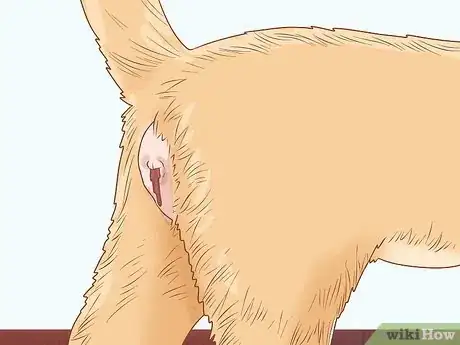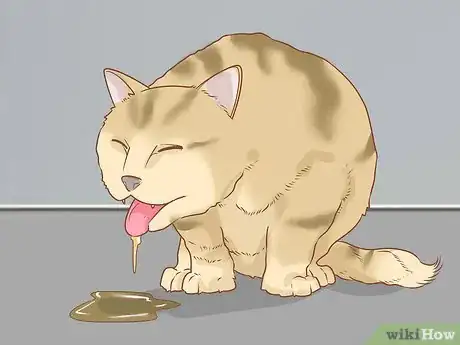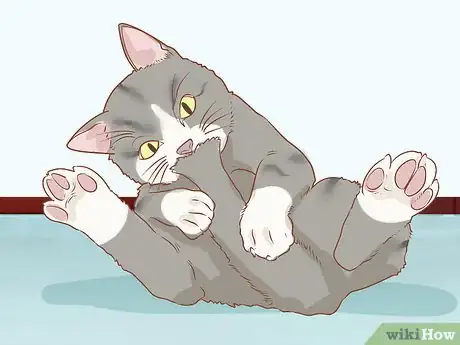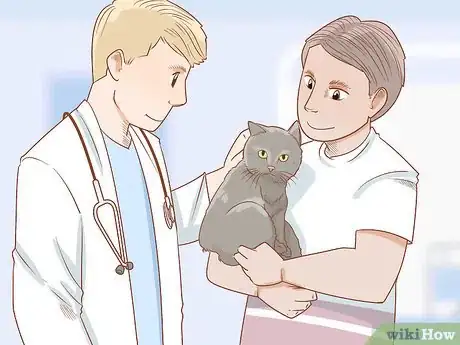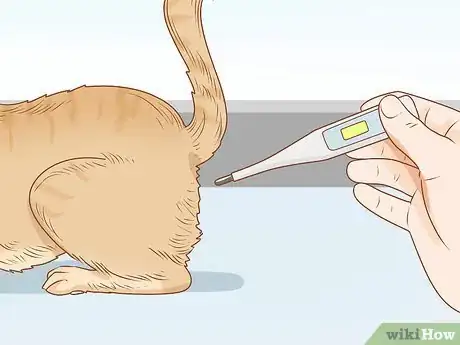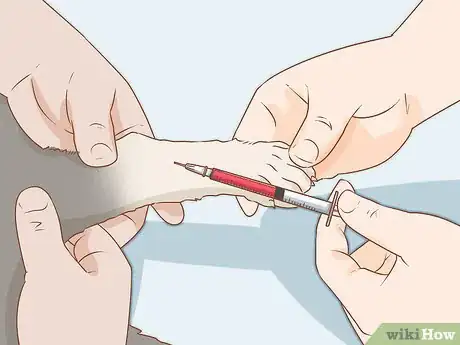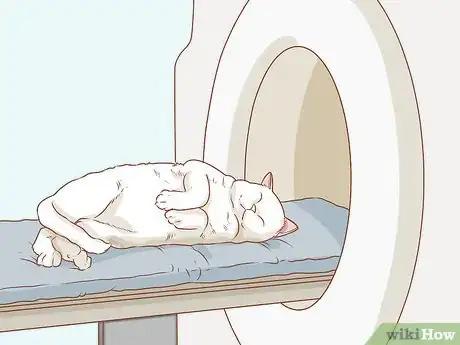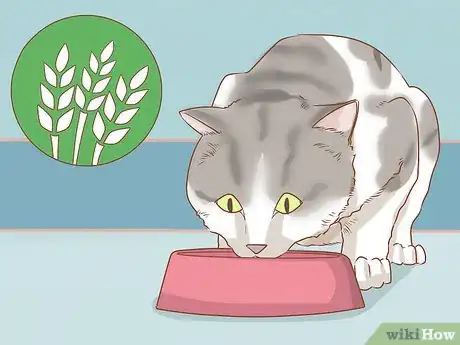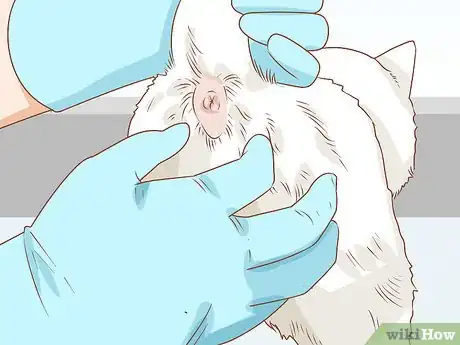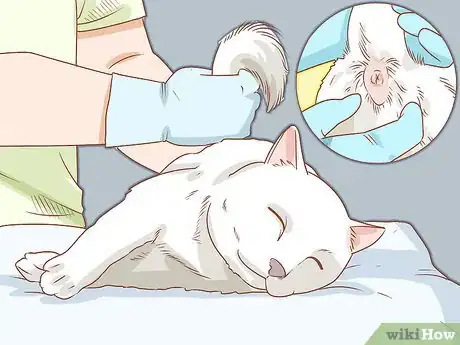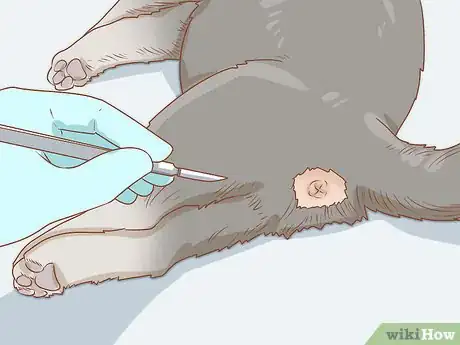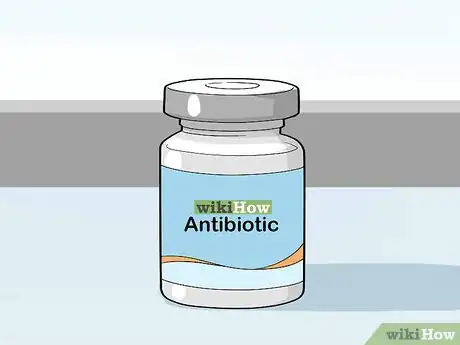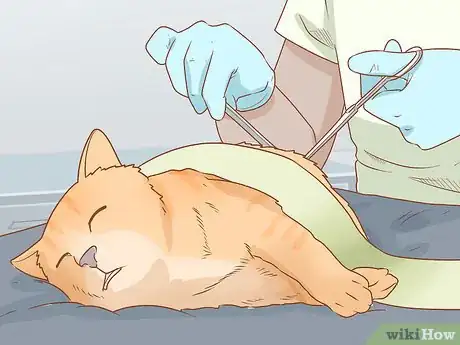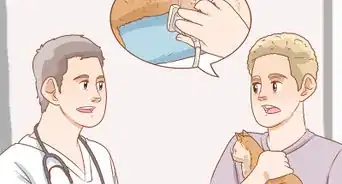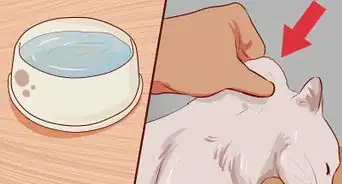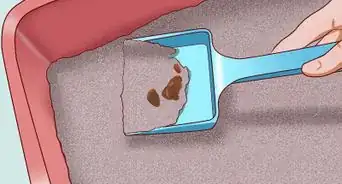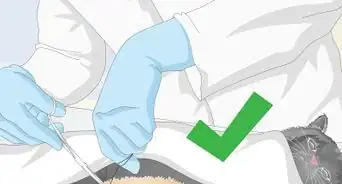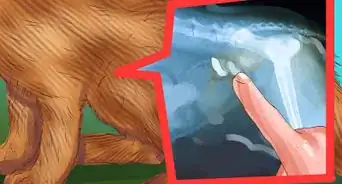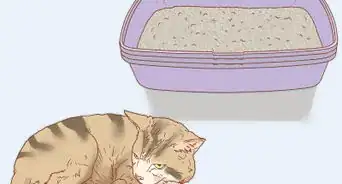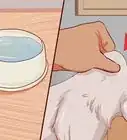This article was co-authored by Deanne Pawlisch, CVT, MA. Deanne Pawlisch is a Certified Veterinary Technician, who does corporate training for veterinary practices and has taught at the NAVTA-approved Veterinary Assistant Program at the Harper College in Illinois and in 2011 was elected to the board of the Veterinary Emergency and Critical Care Foundation. Deanne has been a Board Member of the Veterinary Emergency and Critical Care Foundation in San Antonio, Texas since 2011. She holds a BS in Anthropology from Loyola University and an MA in Anthropology from Northern Illinois University.
There are 7 references cited in this article, which can be found at the bottom of the page.
This article has been viewed 83,320 times.
The anal glands are 2 pouches inside of a cat’s anus. These glands secrete fluid every time your cat has a bowel movement. Sometimes, these glands can get impacted or infected.[1] If your cat has problems with their anal glands, they will rub their bottom across the floor or have swelling around their anus. To treat this condition, your vet will express the glands, lance any abscesses, prescribe antibiotics, or perform surgery.
Steps
Recognizing Symptoms of Anal Gland Disease
-
1Notice the cat favoring their behind. If there are problems with the anal glands, the cat will pay attention to it in a way that you will notice. They may lick it or bite at it. They may also scoot their behind across the floor.
- Your cat does this to try and alleviate the pain and itchiness.
-
2Check for any swelling. The anal glands are 2 glands located on the bottom of the cat inside of the anus. The glands can become swollen if there is something wrong. The tissues may become red around the anal area.[2]Advertisement
-
3Look for any discharge. If the anal glands become too impacted, you may notice a red or bloody discharge coming from their anus. You may also notice the discharge of a pus that is thick and a dark color.
- This discharge may be accompanied by a foul odor.
-
4
-
5Monitor for changes in behavior. Cats who have an anal gland disorder may start acting differently than usual. They may chase their tails more or excessively lick their posterior area. The cat may also be grumpier than usual and may not respond to their owner’s petting or affection.
- Your cat may also be more reluctant to sit than usual.[5]
Diagnosing the Condition
-
1Take your cat to the vet. Any problems with the anal glands needs to be examined by a veterinarian. At the vet, your cat will have a complete physical exam. The vet will also you for a medical history of your cat.[6]
- You will need to tell your vet about any symptoms or odd behaviors of your cat. This can help your vet more accurately diagnose your cat’s condition. For example, your vet may ask you questions about your cat’s defecating habits, including the size, shape, and frequency.
-
2Get a rectal exam for the cat. If the vet suspects anal gland disease, then they will perform a rectal exam. During the rectal exam, your vet may try to empty out the anal glands. They will examine the secretions that come out to look for any abnormalities.[7]
- In some cases, the vet may sedate your cat during this exam.
-
3Have the cat’s blood tested. If the vet believes your cat has an infection or the anal glands are abscessed, they may check the white blood cells, red blood cells, and platelets in the blood. This will help tell them if there is an infection.[8]
- If a tumor is suspected, the vet may do a blood serum chemistry panel. This will test the cat’s organ function, along with the body’s electrolytes.
-
4Get imaging tests if tumors are suspected. If the vet thinks the cat has a tumor of the anal glands, they will start with an x-ray of the chest or abdomen. This looks for any tumors that have spread to the lymph nodes or lungs. X-rays show obvious signs of cancer.[9]
- The vet may also look for tumors via an abdominal ultrasound.
Treating the Condition
-
1Add more fiber to your cat’s diet. Cats with anal gland disease may benefit from a high-fiber diet. The added fiber may help with natural expression of the anal glands during defecation. Speak to your veterinarian about switching to a high-fiber cat food if your cat has anal gland disease.[10]
-
2Have the glands expressed. For many cases, your vet will try to get rid of the fluid impacted in the anal glands. Your vet does this with their finger. They will apply pressure to the glands to push out the fluid. Your cat may need to be sedated during this procedure.
- This is only done if the glands are impacted.
-
3Get the glands flushed. If the glands are impacted and cannot be manually expressed, the vet may flush and irrigate the anal glands. The cat must be put under anesthesia for this procedure. The vet flushes the area with a saline solution.[11]
- This procedure may also be used if the glands have ruptured.
- The saline solution will help to break down the impacted and firm buildup so it can be removed from the glands.
-
4Have the vet lance the abscess. If the anal gland has abscessed, the vet will need to lance it so it can be drained. After lancing the abscess, the abscess is flushed with saline solution to help clear up any backed up or thickened secretions.[12]
- The cat will need to be under anesthesia for this.
-
5Give the cat antibiotics. If there is an infection, the vet will prescribe antibiotics to treat it. The vet may also prescribe antibiotic ointment to rub on the infected area. Topical steroids are sometimes prescribed if the area is inflamed.[13]
-
6Have the anal gland removed surgically. If the anal gland gets infected or impacted frequently, the vet may suggest removing the anal glands. Removal of the glands is also the treatment for anal gland tumors. This is usually the last treatment considered.[14]
- Surgery may lead to fecal incontinence and straining when defecating. This may or may not clear up within a few weeks. Surgically removing the anal glands is considered a salvage procedure.
References
- ↑ https://vcahospitals.com/know-your-pet/anal-sac-disease-in-cats
- ↑ https://vcahospitals.com/know-your-pet/anal-sac-disease-in-cats
- ↑ https://vcahospitals.com/know-your-pet/anal-sac-disease-in-cats
- ↑ http://www.petplace.com/article/cats/diseases-conditions-of-cats/skin/anal-sac-disease-in-cats
- ↑ http://www.petplace.com/article/cats/diseases-conditions-of-cats/skin/anal-sac-disease-in-cats
- ↑ https://www.banfield.com/pet-healthcare/additional-resources/article-library/conditions-illnesses/anal-gland-disease
- ↑ http://www.merckvetmanual.com/digestive-system/diseases-of-the-rectum-and-anus/anal-sac-disease
- ↑ http://www.petplace.com/article/cats/diseases-conditions-of-cats/skin/anal-sac-disease-in-cats
- ↑ http://www.petplace.com/article/cats/diseases-conditions-of-cats/skin/anal-sac-disease-in-cats
- ↑ http://www.peteducation.com/article.cfm?c=1+2122&aid=509
- ↑ https://www.vetary.com/cat/condition/anal-sac-disease
- ↑ http://www.petplace.com/article/cats/diseases-conditions-of-cats/skin/anal-sac-disease-in-cats
- ↑ http://www.petplace.com/article/cats/diseases-conditions-of-cats/skin/anal-sac-disease-in-cats
- ↑ https://vcahospitals.com/know-your-pet/anal-sac-disease-in-cats
About This Article
If you’re concerned that your cat has anal gland disease, watch to see if it frequently licks, bites, or scoots its behind. You might also notice swelling or redness around the anus. Additionally, look for reddish or bloody discharge from the anus, which might also have a bad smell. Some cats have digestive symptoms, too, so check for vomiting, diarrhea, or constipation. Finally, watch for behavioral changes, such as irritability or refusal to sit. If you see any of these symptoms, take your cat to the vet for evaluation and treatment. Scroll down for more tips from our Veterinarian co-author, including how to treat anal gland disease in cats!
